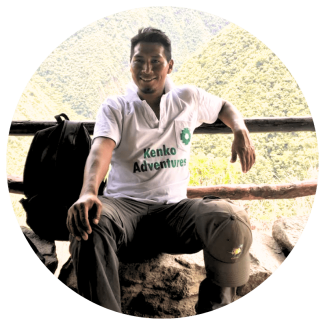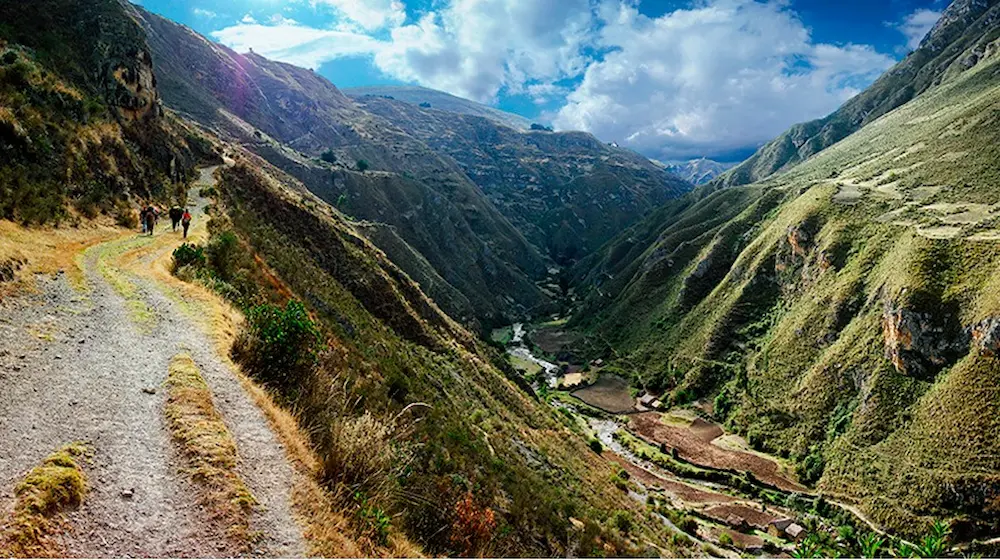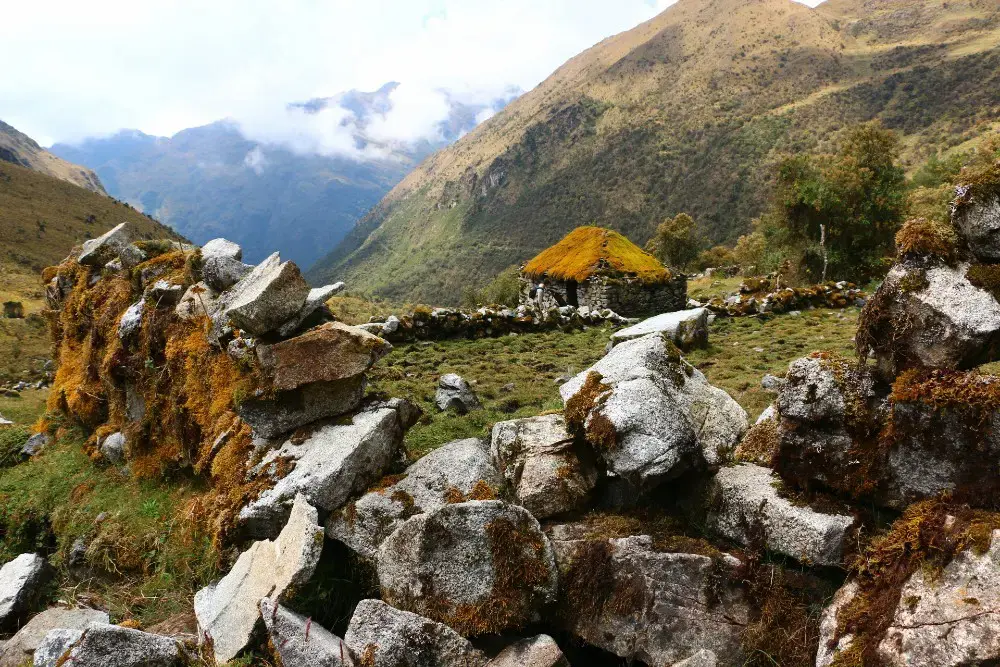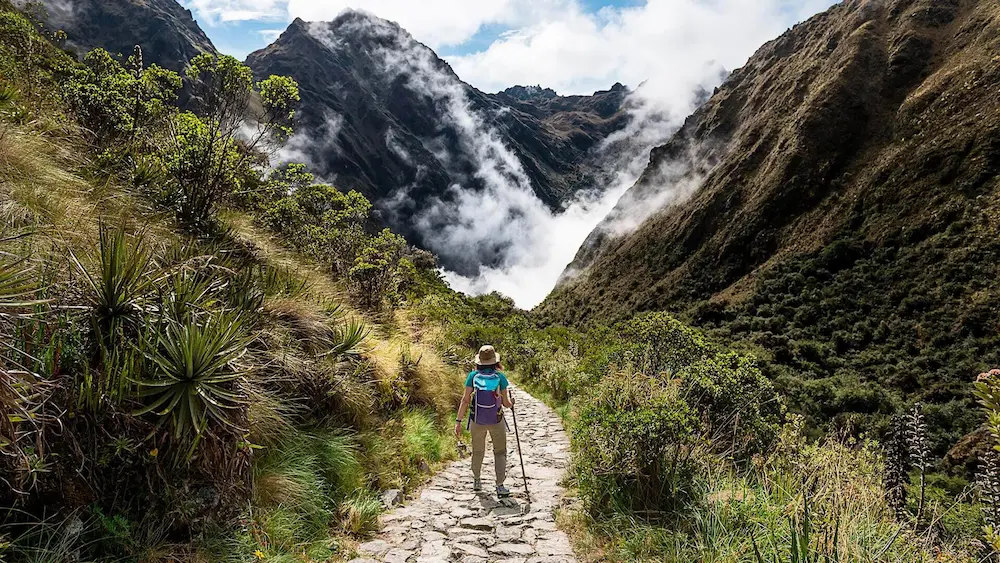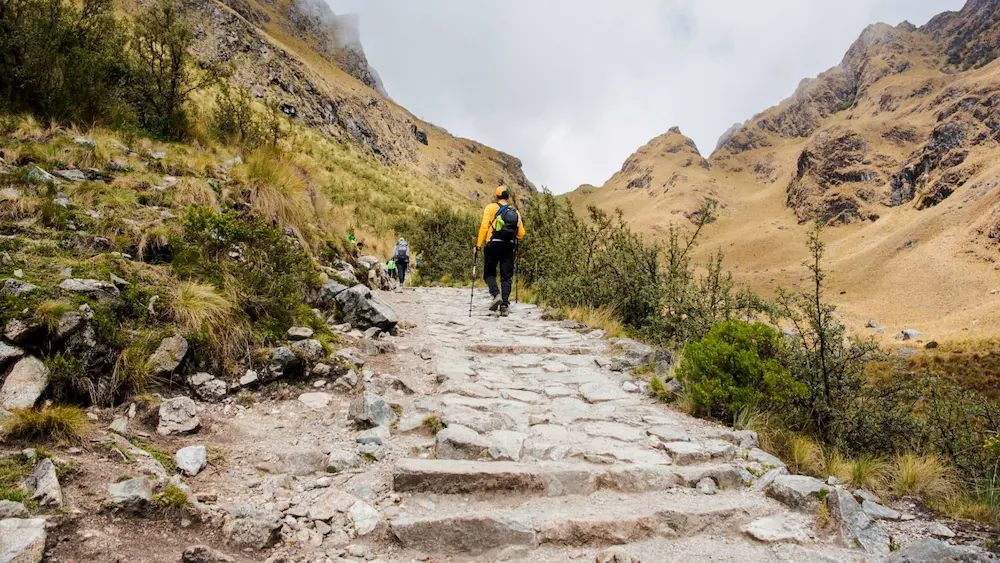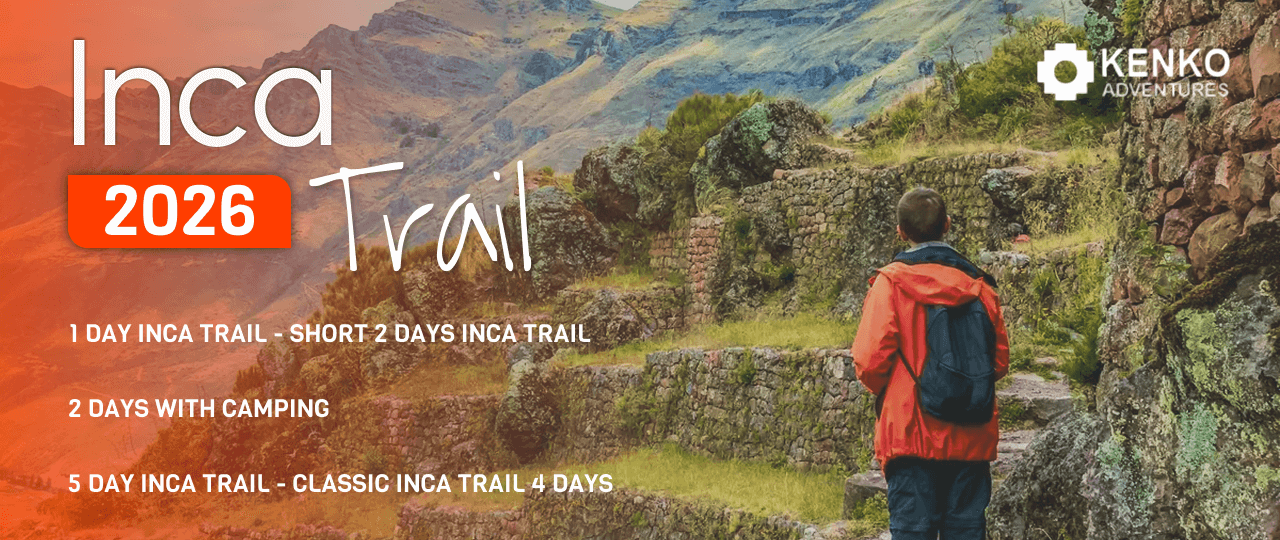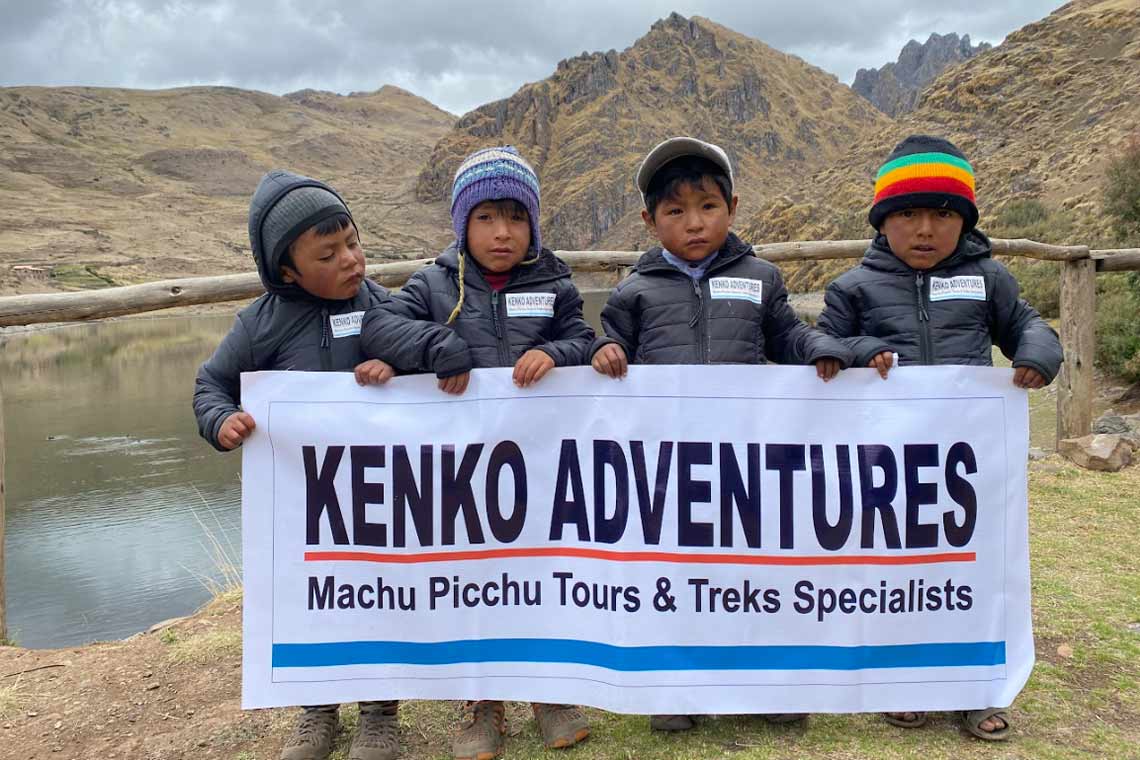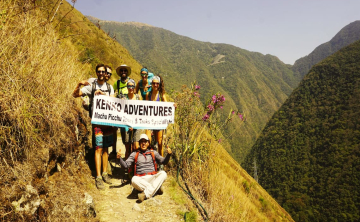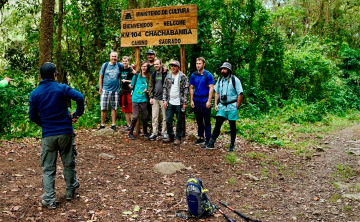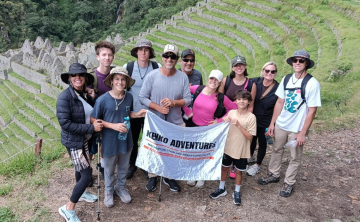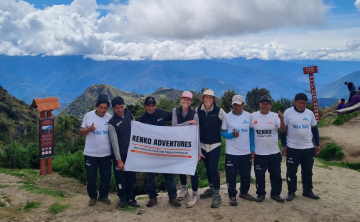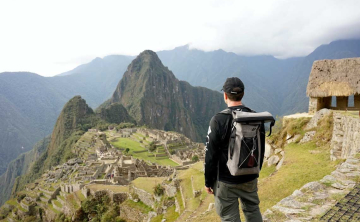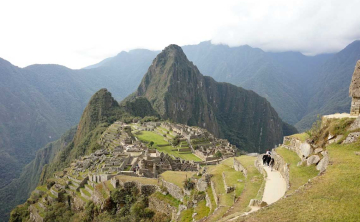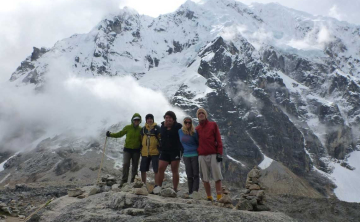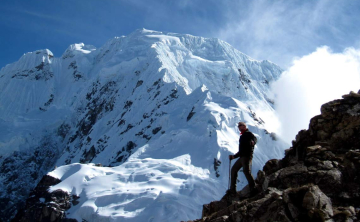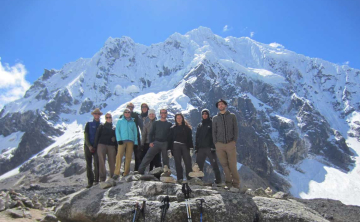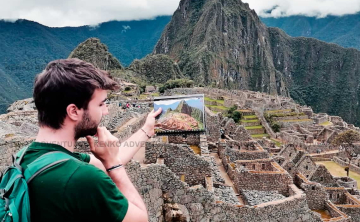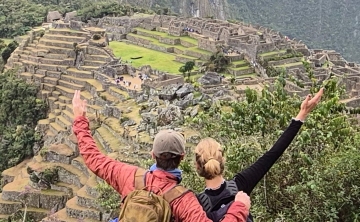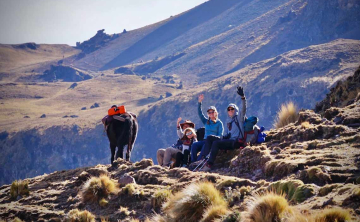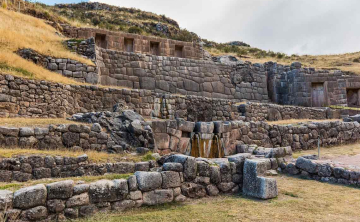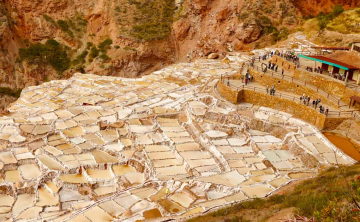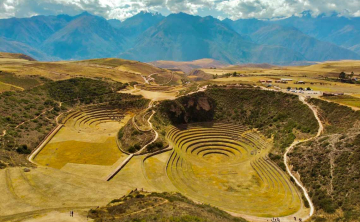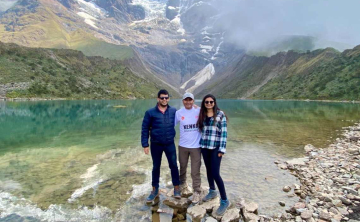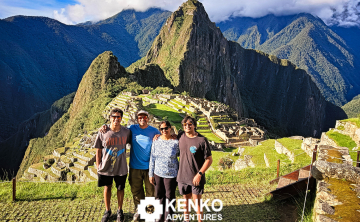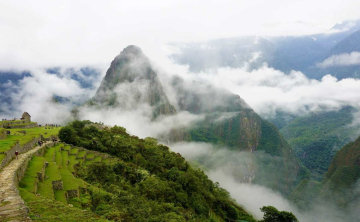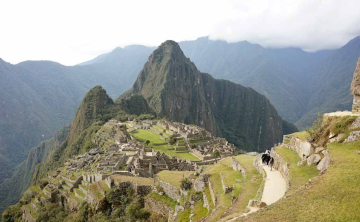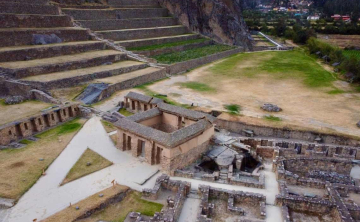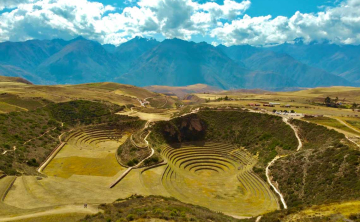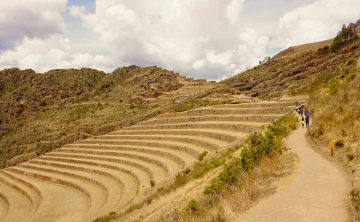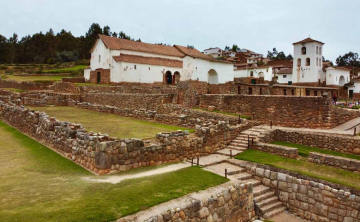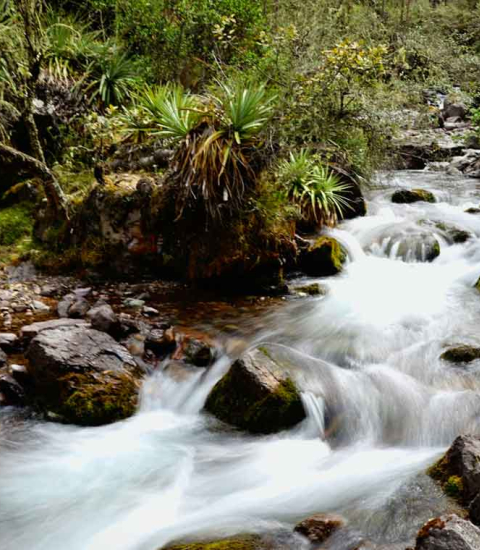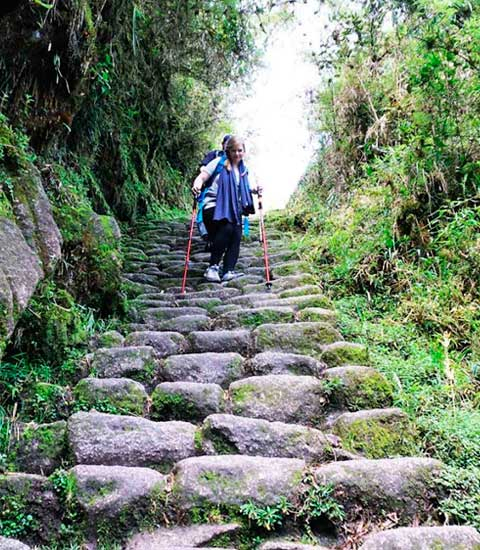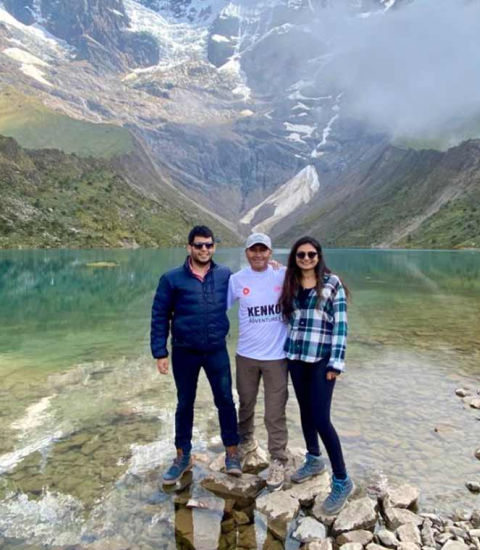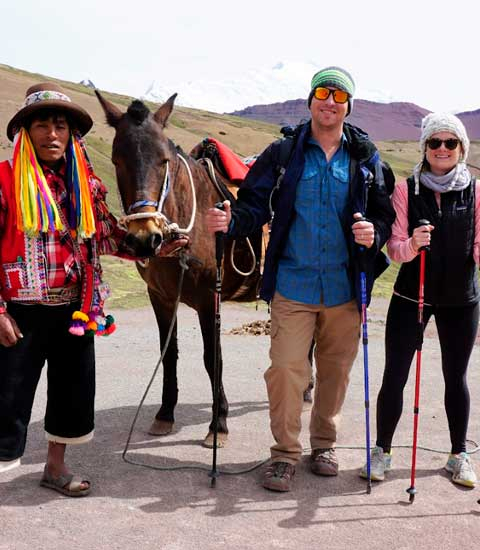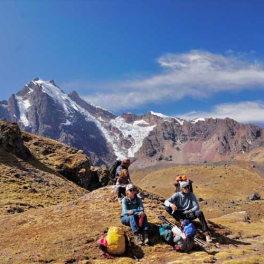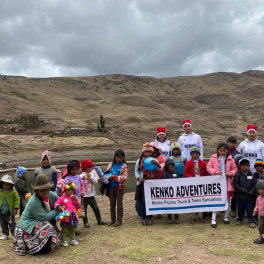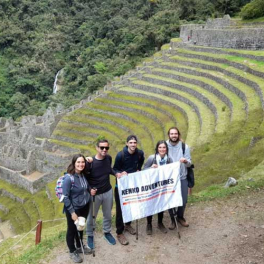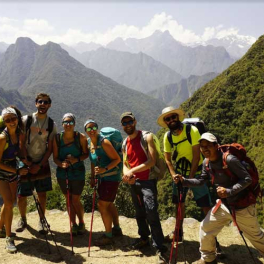The Qhapaq Ă‘an
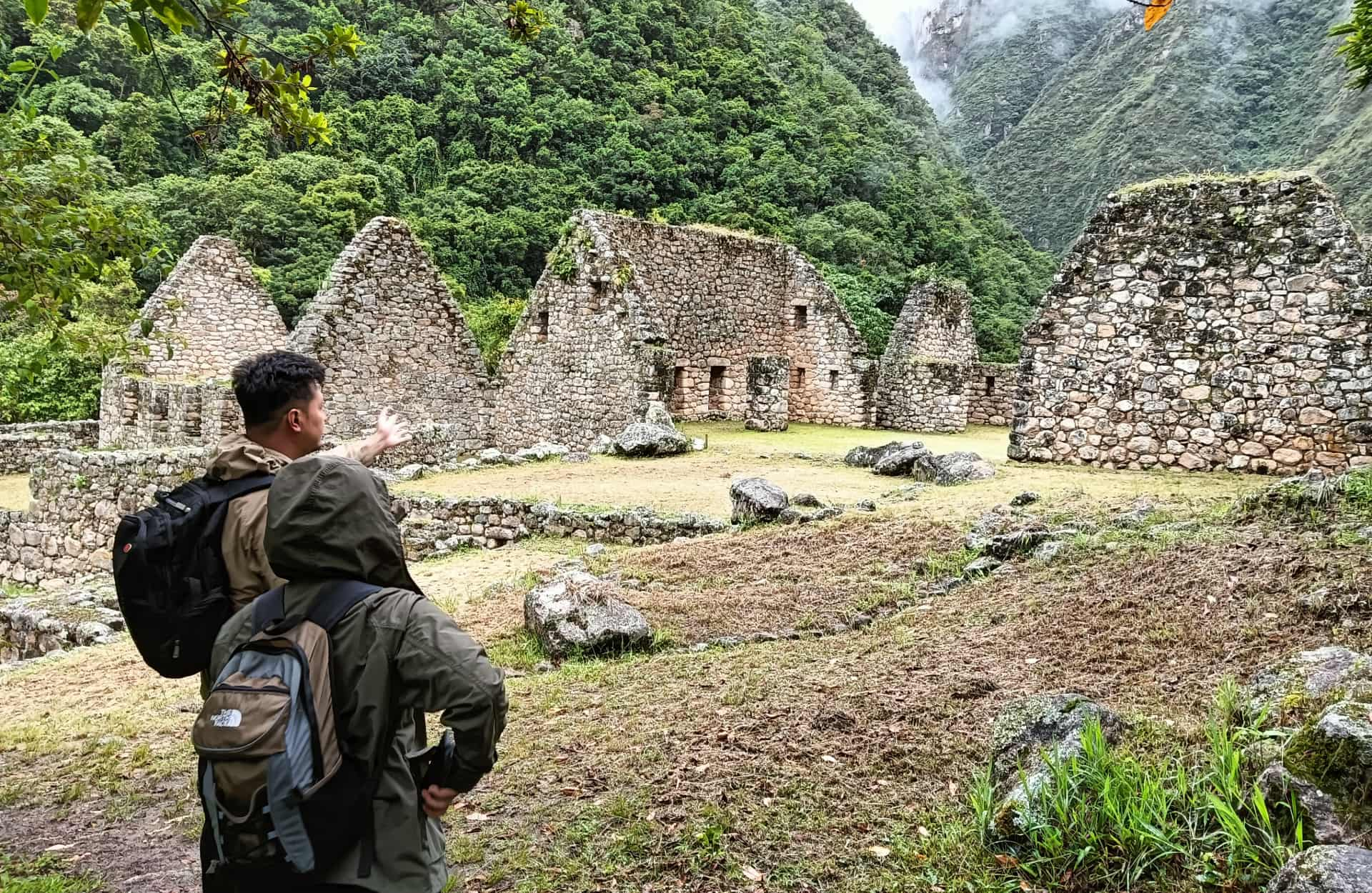
The road network of Tahuantinsuyo (in Quechua, Qhapaq Ă‘an or Inka naani) was an enormous distance system of roads in the Inca civilization that connected important cities on the coast and in the highlands.
It was structured based on two longitudinal axes: the cordilleran sector and the flat coastal sector. Currently, visitors can visit a portion of the Andean network by going through any of the Inca Trail tours, wether if it's the short Inca Trail 2 days tour, the one day Inca Trail tour or the classic Inca Trail 4 days tour.
This Inca system was a millennial legacy of pre-Inca cultures, empowered during the Inca State. In the Quechua language, Qhapaq Ñan means: road of the king or of the powerful, referring both to the entirety of that network of routes, which exceeded 30,000 kilometers, as well as to the main road (approximately 5,200 km long). All of these roads were connected to Cusco, the capital of Tahuantinsuyo or the Inca Empire, facilitating communication with the different annexed peoples within the framework of the Inca expansionist process and, at the same time, constituting an effective means of political-administrative, socio-economic and cultural integration. Since the Qhapaq Ñan interconnected localities as distant as Quito, Cusco and Tucumán, the Spanish conquerors used it during the 16th century to invade Peru, Bolivia, Chile and the Argentine Cordilleran plateaus.
The famous "Inca Trail", which connects the city of Cusco with the historic sanctuary of Machu Picchu, is only a minimal intra-regional part of the gigantic Qhapaq Ă‘an network.
You might also want to check out: What were the incas known for?
What is the Qhapaq ñan?
The qhapaq ñan refers to the vast network of mountain roads built and organized under the Inca Empire, which connected distant regions, communities, and natural resources across the Andes. This ancient “royal road” was not only a physical infrastructure but also a symbol of power, integration and governance by the Incas.
By understanding what the qhapaq ñan is, we can appreciate its scale, its function as an arterial system within the empire, and its enduring importance in terms of history, culture and archaeology.
Origin and meaning of the qhapaq ñan
The term “qhapaq ñan” comes from Quechua: qhapaq meaning “noble”, “main” or “royal”, and ñan meaning “road” or “path”. Together they form the idea of “royal road” — the principal route of the Inca state.
This road network built on earlier pre‑Inca tracks but was systematized and expanded under the Inca Empire. It epitomizes how the Incas linked high mountains, coastlines and jungle regions into a coherent imperial system through the qhapaq ñan.
The role of the qhapaq ñan in the Inca Empire
The qhapaq ñan was far more than a set of paths: it served as the logistical, military and administrative backbone of the Inca civilization. It enabled fast movement of messengers, troops, goods and officials across vast distances.
Thanks to the qhapaq ñan, remote Andean communities, coastal settlements and jungle fringes were linked to the imperial capital in Cusco. It became an instrument of state control, economic redistribution and territorial cohesion.
Why it was declared a UNESCO World Heritage Site
In 2014 the qhapaq ñan was inscribed on the UNESCO World Heritage List under the name “Qhapaq Ñan, Andean Road System.”
The decision reflects its outstanding universal value: an extensive road network crossing some of the world’s most extreme terrains (Andes peaks over 6,000 m), linking coast, highlands and jungle, embodying extraordinary engineering and cultural achievement.
Network in South America
Starting from Cusco, the Qhapaq Ă‘an allowed travel through the four "suyus of the Inca empire" (from the Quechua suyu: 'region' or 'territory') that constituted Tahuantinsuyo:
- to the north the Chinchaysuyo, occupied by groups such as the Chincha, Chimu or Yungas and Pastos;
- to the southeast the Collasuyo, occupied by Aymaras, Qollas and Puquinas;
- to the southwest the Contisuyo, occupied by groups such as the Conti or Conde, Collaguas and settlers of Puquina origin;
- to the east the Antisuyo, occupied by the Antis (the current native populations of the Amazon).
The Qhapaq Ă‘an enabled the economic and political control of these peoples. At the same time, it allowed for their integration, exchange and state mobilization of various products, the transmission of cultural values, access to different Inca shrines and the development of common practices; it was also a symbol of Cusco imperial power and its expansion throughout the South American geography, which included six current Andean countries: Argentina, Bolivia, Chile, Colombia, Ecuador and Peru.
With a total length of 60,000 kilometers, this skillfully constructed backbone by the hands of specialists can be compared, in its dimensions, to the Silk Road or the Great Wall of China.
You might also want to check out: 20 fascinating facts about Inca Culture
Main routes and sections of the qhapaq ñan
The network of the qhapaq ñan is not a single straight line, but a complex web of main arteries and branch roads that traverse high mountains, deserts, forests and coastal regions. Understanding these routes helps us appreciate both the territorial reach and functional diversity of this Andean highway.
In this section, we explore the major routes, key sections within various countries, and how they integrate into what we refer to as the qhapaq ñan network.
The core network and regional branches
The core of the qhapaq ñan originated from the Inca capital of Cusco and branched into four main directions: Chinchaysuyo, Antisuyo, Collasuyo and Contisuyo. From there, numerous regional side‑tracks extended to production zones, settlements and resource areas.
These regional branches allowed the empire to mobilize resources, integrate diverse ecosystems and maintain governance across vast territories — adapting the road design to different terrains: from snowy peaks to jungle edges.
Important stretches in Peru, Ecuador, Bolivia, and beyond
The qhapaq ñan crosses multiple modern nations: sections of it are found in Peru, Ecuador, Bolivia, Argentina, Chile and Colombia. Each country retains distinct segments of the network, representative of local terrain and historic usage. In Peru, for example, there are well‑preserved road segments near Lima, Cusco and JunĂn which show how the coast was connected with highland zones through the qhapaq ñan.
The Inca Trail as part of the qhapaq ñan system
The famous tourist route known as the “Inca Trail” to Machu Picchu is actually one of the segments of the larger qhapaq ñan system. This illustrates that what many know as “Inca Trail” is part of a more expansive Inca road network.
This stretch symbolizes what the qhapaq ñan was in its full form: combining geography, culture and mobility. Hiking it provides a tangible connection to the larger network of Andean highways and the people who once used them.
Architecture and engineering of the qhapaq ñan
Building the qhapaq ñan was a monumental feat: it involved traversing mountains, jungles, deserts and high altitudes. The architecture and engineering that supported it testify to an civilization capable of adapting techniques to extreme environments.
In this section we dig into how the roads were constructed, what innovations they included and how these infrastructures have remained over time, offering insight into the design of the qhapaq ñan.
Construction techniques used by the Incas
Inca engineers used adaptive methods: stone steps carved into rock faces, retaining walls, suspension bridges, drainage systems to avoid erosion, and locally chosen materials adapted to each terrain. Additionally, in zones of high seismic risk or steep slopes, they applied inclined terraces, trapezoidal construction and modular design that permitted maintenance over generations. These construction features highlight that the qhapaq ñan was built not only for function, but for durability.
Bridges, tunnels and infrastructure innovations
One of the major engineering achievements of the qhapaq ñan were suspension bridges — made of plant fibers or stone — tunnels carved through mountains, and other innovative solutions to ensure continuity of the route. Also, the presence of tambos (roadside inns), storage centers, and lookout posts complemented the main road infrastructure, enabling the movement of goods, messengers and military forces across massive distances.
How the qhapaq ñan adapted to geography
The qhapaq ñan crosses altitudes exceeding 6,000 meters in the Andes, arid coastal deserts, tropical jungles and high plateaus. Adapting to this varied geography required that each segment of the road vary in slope design, material, and layout according to its environment.
For example: in mountain passes, stone staircases were used to facilitate llama‑caravan traffic; on the coast, roads used gravel surfaces and containment walls to resist coastal erosion. These adaptations show that the qhapaq ñan was more than a mere path — it was a system intelligently designed for its terrain.
You might also want to check out: Inca calendar: Solar alignments at Machu Picchu
Cultural and spiritual significance of the qhapaq ñan
The qhapaq ñan was not only a physical route but also a cultural landscape charged with symbolic, religious and social meaning for Andean peoples. Walking its segments is to engage with how the material and spiritual worlds overlapped.
In this section we explore the ceremonial sites along the route, connections to Andean cosmology and how the qhapaq ñan remains today a living symbol of identity.
Ceremonial sites along the route
Along the qhapaq ñan one finds tambos, administrative centres and ceremonial sites used for rituals, offerings and celebrations related to mountains, water and fertility. These places strengthened imperial presence and connected communities to sacred terrain.
In these spaces, the road also functioned as a conduit of cultural practice: pilgrims, officials and local communities moved along it in ways that merged practical travel with spiritual purpose.
Connections with Andean cosmology and sacred landscapes
Andean cosmology places mountains (“apus”), rivers and natural sources at the centre of spiritual life. The qhapaq ñan traversed such sacred spaces and allowed the Inca state to insert its infrastructure into the landscape of gods and ancestors.
This interweaving of religion, territory and infrastructure means that the qhapaq ñan functioned as more than transport — it was a pathway of meaning linking human society to the sacred. Many communities along its route still maintain rituals connected to the trail, the earth and the water.
The qhapaq ñan as a symbol of Inca identity
For the Inca empire, the qhapaq ñan represented state power, territorial integration and identity. It expressed how the empire envisioned unity across diverse landscapes and peoples.
Today, it remains a symbol of Andean identity: cultural resilience, collective memory and connection to a legacy that spans beyond modern national borders. Communities living along its path maintain its significance, honoring traditions and heritage that flow along the road.
The Roads before Tahuantinsuyo
Several of the roads currently observed in the Andean area occupied by Tahuantinsuyo had a pre-Inca origin, having been built by highly complex political entities such as Tiahuanaco or Huari; other minor roads, however, were built by small ethnic groups that tried to connect places of worship or regional temples. Such is the case of the road built between the temple of Pachacamac (facing the sea) and the "apu" Pariacaca, a snow-capped peak located at more than 5,700 meters above sea level.
The quantity and length of the roads in the pre-Inca era was limited by the constant tensions and warlike environment experienced by the lordships and states; road construction was dangerous and only some sections were built during periods of truce. Before the arrival of the Incas, the roads were exclusively local; it was only with their arrival and centralizing power that the road network expanded to great magnitudes.
You might also want to check out: A guide to hiking to the Sun Gate (Inti Punku)
The Roads during Tahuantinsuyo
When the Incas began conquering the rest of the Andean peoples, the dominion of space for road construction was entirely at the disposal of the Cusco ethnic group; from this moment on, the road networks increased exponentially until covering an extension that possibly reached 60,000 kilometers.
The beginning of the great road works was carried out by express order of the Inca Pachacutec. This sovereign saw the need to build roads with the aim of maintaining control over the annexed territories, so that officials and troops could be moved more quickly.
As Juan de Betanzos points out, before Pachacutec began his reign, he was observed painting and drawing roads and bridges, specifying to the Cusco noblemen the way they should be built. Pachacutec's work was continued by his successors. The Inca road network consisted of three basic elements: the roadways and edges of the roads, the bridges and the warehouses.
The road network was indispensable for the Inca organization, not only to move armies and officials but also for the mobilization of the "mitimaes", the transport of products harvested in the territories conquered by the Incas (in each territory there were lands specifically destined for their production to be transported to Cusco; these harvests were stored in the "tambos") and the movement of the "chasquis" (messenger runners).
The Qhapaq Ă‘an and Other Roads
Being the main trunk of the entire Inca road network, the Qhapaq Ă‘an stood out for running longitudinally throughout Tahuantinsuyo (the Inca Empire) along the Andean mountain range, from the current western Argentina to southern Colombia. The Inca Trail is paved for much of its length and is several meters wide. Parallel to the Inca Trail, there was a road that connected the coastal towns, which at that time were called "yungas".
This coastal road was connected to the Qhapaq Ă‘an by several transverse roads that even reached the jungles and the Gran Chaco (Argentina, Bolivia and Paraguay). In the case of the coastal road, it was not paved but its edges were delimited.
The Spanish chroniclers described the Qhapaq Ñan with praise, some extolling its "excellent" functioning while others highlighted its straightness in some sections and its cleanliness, adding that they could cover great distances in a short time and with minimal effort. According to Bernabé Cobo, the Inca roads narrowed when passing through valleys and ravines, and the chronicler described that the roads had high walls that in some cases had animals and monstrous beings painted on them; these walls served so that the armies could pass without damaging the crops.
It is known that the "curacas" (local chiefs) were obliged to order the maintenance of the roads near their domains, clearing the accumulation of soil on the roads, repairing the paving and cleaning the ditches that protected the roads. The appearance of the roads when leaving the valleys was different, since the roads became wider and it was very common to see piles of stones that marked the steep points between the hills, these piles were called "apachetas". As noted by George Squier between 1863 and 1865, that old custom of leaving stones on the difficult slopes of the Inca roads turned them over time into markers, like milestones, that demarcated these roads.
To deal with muddy areas, it was necessary to build a base made of rough stone joined with a clay mortar that was finally covered with sod, forming an embankment. Below this embankment, drainage channels were made to eliminate excess water. For steep slopes, they built staircases or zigzagged the roads.
In general, there was no single design pattern for the Inca roads; rather, they adapted to the topography they crossed. The layout depended largely on factors such as the population density of the areas to be connected or the economic importance of the site to which the road was headed. And, although it is true that the Incas preferred to lay out their roads in a straight line, the rugged terrain forced them to delineate their roads avoiding obstacles.
You might also want to check out: Weather in Peru
Modern importance of the Qhapaq ñan
Though built in pre‑Hispanic times, the qhapaq ñan remains relevant today. It’s an object of cultural heritage, tourism, archaeological research and community development.
In this section we examine its contemporary value, preservation challenges and how local populations are revitalizing the qhapaq ñan.
Its value for tourism and cultural heritage
The qhapaq ñan offers routes of significant tourism value: for hikers, history lovers and cultural travelers who want to experience a great ancient legacy. These pathways allow for immersion into nature, archaeology and Andean culture.
As a transnational cultural property shared across multiple countries, the qhapaq ñan promotes cross‑border tourism and cultural exchange, benefiting local communities through sustainable practices.
Conservation challenges and preservation efforts
Preserving the qhapaq ñan faces numerous challenges: weathering over time, urban expansion, unregulated tourism, climate change and resource limitations in remote areas. Fortunately, there are coordinated efforts by Andean nations to protect this heritage.
These initiatives include community participation, restoration projects and international cooperation — aiming to keep the qhapaq ñan a living path, rather than just a relic of the past.
How local communities are revitalizing the qhapaq ñan
Local communities play a key role in safeguarding the qhapaq ñan: as custodians of the road, guides for visitors, researchers and beneficiaries of heritage tourism. This engagement strengthens both cultural identity and local economies.
Through community tourism, heritage education and recognition of ancestral rights, the populations along the qhapaq ñan are turning this legacy into a source of sustainable development and cultural empowerment.
How to visit and experience the qhapaq ñan
Visiting the qhapaq ñan means immersing yourself in history, culture and nature. But to do so well, planning, respect for heritage and a mindset of discovery are key.
In this section we provide the best sections to explore, travel tips, and best practices for visiting the qhapaq ñan responsibly.
Best sections to hike or explore
Some of the most recommended segments of the qhapaq ñan include trails near Cusco, the Portachuelo‑Piticocha section in Lima, and stretches in Ecuador and Bolivia. These allow access to original road fabric with fewer crowds than mainstream tourist routes.
Turismo Salta
When choosing a segment, consider the difficulty level, altitude, length and logistics. Some apply multi‑day mountain hikes; others are accessible for shorter, guided walks.
Travel tips and what to expect
Exploring the qhapaq ñan means dealing with altitude, changing weather, varied terrain and archaeological features. It’s key to bring proper footwear, acclimatize to height, respect protected zones and hire certified guides.
Also check on permits, local regulations and optimal season — as some segments may be inaccessible during heavy rains or under maintenance. Knowing the conditions enhances your experience of the qhapaq ñan.
You might also want to check out: The Inca Culture History
Bridges
The Q'eswachaca hanging bridge made of an ichu fiber called "qoya ichu". The renewal of this bridge is done through a 4-day ritual that has been maintained since the Inca period.
The construction of bridges became indispensable due to the Andean geographical reality. The most common bridges were those made with tree trunks and those made by braiding various fibers. In the case of trunk bridges, they were only used in places where the geography allowed it, and for this, a stone base was needed (two opposing rock outcrops) that were carved so that the logs would fit snugly. In the early colonial times, Miguel de Estete stated that at the exit of Huánuco Pampa there was a bridge made with thick logs, while near Cajamarca there was a bridge made with stone bases and very thick logs.
Hanging bridges were the most common in the Andean region. They were built with plant fibers that were attached to solid stone bases on each side; these fibers were braided to form cables 50 or 60 centimeters in diameter, and to pass the cord from one place to another, a thinner hemp rope called "chahuar" was used. The fiber for the bridges varied by region - they could be made of wicker, tasca (Escallonia patens), lloque (Kageneckia lanceolata), ichu (Stipa ichu) or chachacomo (Escallonia resinosa); in some areas the so-called "Chilca shrub" (Baccharis latifolia) was used. In areas where there were no shrubs, maguey (Furcraea andina) fiber was also used, a fiber also known as "pita" or "cabuya". In some cases the bridges had laid tree trunks to facilitate transit, but most often they had woven or intertwined fibers.
It should be noted that most of the Inca bridges were burned during the civil wars between the Spanish conquerors and the Manco Inca uprising. The French Account of the Conquest (written in 1534) describes that in the Indies there were powerful rivers from which bridges of thick ropes hung, and that there were bridges where the great lords passed and others where the common people passed.
The rivers could also be crossed by means of oroyas (also called tarabitas or huaros, depending on the region). Bernabé Cobo describes that these "tarabitas" were made with ichu ropes or vines as thick as a leg. These ropes were tied to rocks from one bank to the other and from them hung a basket, on which a person would sit and pull themselves across by the rope from one bank to the other.
In the case of the Desaguadero River, there was a floating bridge made by a row of totora reed rafts covered with various dry aquatic plants (including totora reeds). According to testimonies gathered by the chroniclers, this bridge over the Desaguadero was placed by order of the Inca Huayna Capac, who considered it unbecoming for his army to cross the river on rafts.
Kenko Adventures is a Cusco tour operator that offers the chance of covering the section of the Qhapaq Ă‘an known currently as the "Inca Trail".
Contact us to receive more information on your end and begin with your traveling plans in Peru with the most trustable agency in the region.
